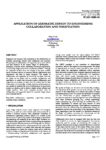
|
Application of Axiomatic Design to Engineering Collaboration and Negotiation
Suh, Nam P.
4th International Conference on Axiomatic Design, 2006
Engineers and managers who participate in the development of complex engineering systems often collaborate and negotiate. The purpose of collaboration and negotiation is to make correct and best decisions at the various stages of development — identifying customer needs, establishing functional requirements, and selecting design parameters and process variables – through the collection of best ideas and analysis of the best available inputs. However, there is no assurance that all collaborations and negotiations will lead to better decisions. The quality of collaboration and negotiation is affected by two basic elements: the system and the process used to promote collaboration and negotiation. A system that promotes positive collaboration and negotiation is necessary to assure that the project has the best information and knowledge available. Systems and processes are also needed to minimize the cost of development, to execute the project on schedule, and to deliver a highly robust, efficient and reliable product. This paper proposes heuristic rules of collaboration and negotiation based on axiomatic design theory and complexity theory.
|
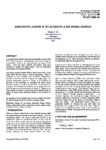
|
Amending Axiom II to Achieve a Six Sigma Design
Oh, Hilario L.
4th International Conference on Axiomatic Design, 2006
A six sigma design delivers the design functionality on target with little variation around it. Consequently, it has a wide margin to accommodate errors in the manufacturing and usage of the design. Over the years, methods and metrics have been developed to achieve six sigma designs. They are collectively called Design for Six Sigma (DFSS). One design principle behind DFSS is that it must focus on the target rather than the range of design functionality. Axiom I conforms to such principle since functional independence provides a metric for ease of tuning to the design target. By contrast, information content in Axiom II by definition is focused on the probability of exceeding the design range. Therefore Axiom II needs to be amended. In this paper, we proposed and developed the sensitivity of the design to deviate from its target as a metric to implement Axiom II. Together, the design matrix of Axiom I and the proposed sensitivity matrix of Axiom II, should bring Axiomatic Design to the forefront of DFSS.
|
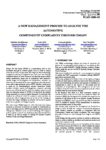
|
A new management process to analyse the automotive components’ complaints through DMADV
Arcidiacono, Gabriele, Paolo Citti, Pasquale Antico, Sara Torricini
4th International Conference on Axiomatic Design, 2006
Design For Six Sigma (DFSS) is a methodology able to join innovative thought to several analytic tools in order to design products, services and processes. The target of this methodology consists of reducing development time and cycle time through combined efforts of many resources and through process design within specification target and in compliance with excellence. Usually design and development are independent activities on other internal functions of the same organization, but this doesn’t occur with a right approach such as DFSS. Exactly a work group is made up of interdisciplinary experts: know-how holder, statistical method experts and prospective customer especially internal one; all this is useful to tackle the problem with an overall view. An important aspect of DFSS is to transform the reactive design approach in a more proactive approach. In particular this requires: to understand what the customer wants up front, to control the critical design parameters as part of the analysis, to calculate the design capability, to measure and to test in quality rather than to predict and design in quality.
|
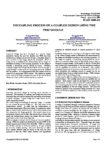
|
Decoupling Process of a Coupled Design using Triz Modules
Shin, Gwang-Seob, Gyung-Jin Park
4th International Conference on Axiomatic Design, 2006
Axiomatic Design has been developed as a general design framework during the past two decades and TRIZ has been developed as a design tool for over 50 years. Axiomatic design is quite excellent in that design should be decoupled. When a design matrix is established, the characteristics of the design are identified according to the coupling properties. If the design is coupled, a decoupling process should be found. However, axiomatic design does not specifically indicate how to decouple a coupled design. In this paper, the decoupling process is classified into six patterns. It is demonstrated that each pattern could be solved by an appropriate TRIZ module. The method is applied to the conceptual design processes of a tape feeder and the beam adjuster of a laser marker, and the results are analyzed.
|
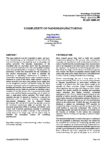
|
Complexity of Nanomanufacturing
Kim, Sang-Gook
4th International Conference on Axiomatic Design, 2006
This paper addresses how the complexity in micro- and nanoscale manufacturing can be understood and then reduced for real manufacturing of tiny products such as microchips and carbon nanotubes. The axiomatic interpretation of the monolithic idea for microchips shows that the information content could be drastically reduced by printing MOS transistors rather than assembling discrete transistors. It also shows that the information content well characterizes the real complexity of tiny product manufacturing. An effort to minimize the complexity of assembling nanostructures is described. A deterministic assembly process for carbon nanotubes has been developed as a part of this effort, which embeds a bundle of carbon nanotubes into micro-scale polymer blocks, which then can be transplanted, oriented and bonded readily. The block serves as a micro-scale carrier of nanostructures, facilitating their handling and assembly. More recently, we have developed a new transplanting process, which can assemble an individual carbon nanotube to a specific location. The new process produces high aspect ratio cylindrical blocks (nanocandles), each of which can carry a single-strand carbon nanotube. The buried carbon nanotube can later be exposed to function as a nano-tip for applications such as atomic-scale scanning, nano-pipetting, nano-thermal lithography, and tip enhanced Raman spectroscopy. The concept of transplanting assembly uncouples the functional requirements (FRs) of assembly from the functional requirements (FRs) of synthesis, and thereby could control each functional requirement optimally in assembling nanostructures such as carbon nanotubes. It also increases the overlap between the design range and the system range to minimize the information content for assembling nanostructures.
|
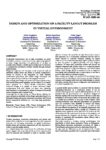
|
Design and optimization of a facility Layout problem in Virtual Environment
Fruggiero, Fabio, Alfredo Lambiase, Fabio Negri
4th International Conference on Axiomatic Design, 2006
Productivity improvement, due to high competition on global marketplace, requires a concurrent/reverse engineering approach to layout design, simulation and optimization in as short as possible times. Besides, a facility layout problem can be viewed as a combinatorial optimization problem solvable through heuristic methodologies. Designers, engineers and managers needs automated tools to effectively analyze layout and define an optimal configuration. Central to success is the integration of multi objective mathematical procedures with robust design techniques and virtual representation/validation in stereoscopic real scale. Flow analysis, plant design and optimal 3-D layout representation, with virtual environment validation, are the objects in our facility layout approach. In a Virtual Reality environment, using Axiomatic Design, it is possible to analyze alternative design configurations with little efforts and short time, obtaining improvements in communication, savings in changes and assuring design integration with computer tools. Encouraged by the big interest on Virtual Reality abilities, the paper presents an innovative robust design application based on a Rectangle-Packing placement optimization procedure with Virtual Reality environment validation of a real flow shop production process.
|
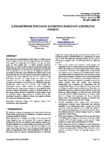
|
A framework for lean logistics based on Axiomatic Design
Houshmand, Mahmoud, Mohammad Daneshvar Kakhki,
4th International Conference on Axiomatic Design, 2006
Well designed and implemented supply chain is a critical success factor in global markets. Therefore organizations try to improve their supply chain processes and eliminate any type of waste (such as time, quality and …) within business processes. Elimination of wastes could be attained trough lean logistics and begins with diagnosis. In the next step, organization should define several projects to cure the roots of the problems which are recognized in diagnosis. Lean activities face failure most of the time since they are not well designed and planned. Definition of projects is the most important part of lean activities. Using hierarchical structure of design based on axiom one, an uncoupled plan can be designed. An appropriate practical structure and schedule is the outcome of mentioned approach. Considering axiom two, the outcome will contain low information content which reduces the failure probability. Considering value engineering techniques in decomposing design structure, reduces information content of defined projects. In this paper, authors present a framework for lean logistics based on axiomatic design. Along comes an industrial survey. The mentioned structure is utilized to design lean logistics activities for a sedan car manufacturer in Iran.
|
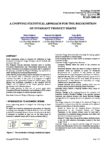
|
A unifying statistical approach for the recognition of invariant product shapes
Chiabert, Paolo, Manuela De Maddis, Suela Ruffa
4th International Conference on Axiomatic Design, 2006
Every engineering system is designed for delivering its basic functions and Axiomatic design develops a list of methods able to attempt this task. The designers through axiomatic principles have to translate Functional Requirements into Geometrical Requirements and develop verification and validation procedure able to establish if the process, controlled by Physical Variables, has produced an object satisfying the Functional Requirements. Given that the product design cannot reasonably be assured if it is not coupled with a verification procedure that is unique, universal, repeatable, in this paper it is proposed an original approach to the geometrical control of product shape which exploits the potentiality embedded in the standard ISO/TS 17450-1 and in particular in the duality principle between specification and verification phases. The duality principle is only one of several tools which Geometrical Product Specification and verification (GPS) project provides to the designer to achieve axiomatic quality.
|
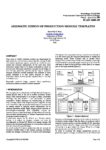
|
Axiomatic Design of Production Module Templates
Matt, Dominik T.
4th International Conference on Axiomatic Design, 2006
Since most of today’s industrial products are characterized by high complexity and numerous customer-specific variants, flexible and adaptive production system concepts are needed to meet market and customer requirements. At the same time, these production systems have to be highly competitive in terms of cost per unit. This paper introduces a concept for the design of lean and agile production systems with the help of axiomatic designed production module templates. The objective of these generic templates is to help system designers to adapt a production module to their specific requirements in a very fast and efficient way.
|

|
The Physics, Principles and Psychology of System Design
Cochran, David S.
4th International Conference on Axiomatic Design, 2006
Best known as the godfather of Quantum Mechanics, David Bohm’s work in the latter part of his life dealt with the physics of systems that include people. This paper will review David Bohm’s work on dialogue and the physics of systems. Proposed will be a methodology for system design that includes people, called Collective System Design, that integrates the use of axiomatic design theory and the physics of systems to suggest the principles and methodology that implements new systems (i.e., lean and six sigma) effectively in simple and complex organizations alike.
|
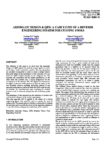
|
Axiomatic Design & QFD: a case study of a reverse engineering system for cutting tools
Del Taglia, Andrea, Gianni Campatelli
4th International Conference on Axiomatic Design, 2006
The objective of this paper is to show how the Axiomatic Design and QFD approaches could be merged together in order to develop a market competitive product. The two approaches are operated consequently in order to create a design solution that could satisfy all the expectations of the customers. On one hand the QFD analysis provides to the designers the data regarding the competitors and the market expectations, on the other hand this provides also a strong background for the development of the solution. The AD approach is focused on the high-level structure of the product, so allow the choice of the best technical solutions regarding decoupling (Axiom I) and expected performances (Axiom II) while the QFD could be used to minimize the manufacturing costs evaluating the detailed product needs in terms of components and machining quality level.
|
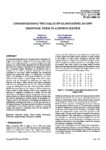
|
Understanding the Value of Eliminating an Off-diagonal Term in a Design Matrix
Lee, Taesik, Peter N. Jeziorek
4th International Conference on Axiomatic Design, 2006
In Axiomatic Design theory, it is strongly desired to eliminate offdiagonal elements from a design matrix as the two design axioms imply an ideal design would have an uncoupled design matrix. For example, in a coupled design, eliminating the off-diagonal term(s) that cause the coupling is mandated by the independence axiom. For a decoupled design, eliminating an off-diagonal term is desirable as it tends to increase robustness and reduces complexity of the design. While eliminating any off-diagonal element does benefit the design in a certain way to a certain degree, each off-diagonal element presents different value when eliminated. For example, a coupled design matrix with a unique structure may be decoupled by eliminating one critical offdiagonal term while a trivial solution may require eliminating more than one off-diagonal terms. Even in a decoupled design, each of the off-diagonal terms when eliminated yields a different FR-DP interaction structure that leads to a different implication in the context of design iteration. This in turn is related to the reduction of imaginary complexity for a design. The fact that eliminating an off-diagonal element among more than one offdiagonal terms is not equally effective in improving a design raises the need for developing an optimal strategy for eliminating offdiagonal element. The first step in developing such strategy is to quantitatively understand the value of (or the lack there of) an off-diagonal element. This paper examines the effect of removing an off-diagonal term to build a basis for an optimum decoupling strategy and presents a preliminary result for the methods to construct an optimal strategy.
|

|
Integrating Axiomatic Design into a Design For Six Sigma Deployment
Dickinson, Allan L.
4th International Conference on Axiomatic Design, 2006
Design For Six Sigma (DFSS) is a systematic process for design conception intended to yield robust products that meet customer expectations. Robustness is defined here as product performance that is insensitive to variation, both in manufacturing and in the application environment. It is widely accepted that no amount of robust optimization at the detailed design level can succeed if the design concept itself is flawed (does not satisfy all functional requirements). The author has specifically focused on DFSS deployment in his company in the area of concept generation. Integration of Axiomatic Design has been the most critical element of this improvement. This paper describes how Axiomatic Design has been integrated smoothly into a pre-existing DFSS deployment. It demonstrates how Axiomatic Design links with other wellaccepted DFSS tools. The author emphasizes the importance of educating leadership and utilizing experienced trainers of axiomatic design to ensure deployment success.
|
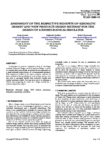
|
Assessment of the respective benefits of ‘Axiomatic Design’ and ‘New Products Design Method’ forthe design of a Biomechanical Simulator
Evrard, Hugo, Stéphanie Buisine, Robert Duchamp
4th International Conference on Axiomatic Design, 2006
In this paper we present a comparative study of two design methods: Axiomatic Design and New Products Design. In order to compare them more closely, we applied the two approaches to a single industrial project (design of a biomechanical simulator). This experiment enabled us to collect empirical evidences to better understand the specificities of each method, and we were thus able to accurately identify their respective benefits and primary application fields. Our long-term goal is to elaborate a didactic tool supporting the choice of a design method for a particular application project.
|
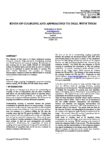
|
Kinds of Coupling and Approaches to Deal with Them
Brown, Christopher A.
4th International Conference on Axiomatic Design, 2006
The objective of this paper is to better understand coupling during the axiomatic design process by decomposing coupling into “kinds” based on the causes of coupling. The premises are that coupling can be more readily detected by systematically looking for different kinds, and that there are types of solutions that can be developed to address the kinds of coupling. The paper includes discussions and examples of coupling decomposition, methods to detect the different kinds of coupling, and procedures to find solutions to couplings.
|
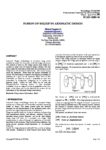
|
Fusion of Belief in Axiomatic Design
Pappalardo, Michele
4th International Conference on Axiomatic Design, 2006
Axiomatic Design methodology is developed using matrix methods to analyze the innovation needs into design parameters. The method is based on two design axioms from which it is possible to derive rules for improve design activities. The first axiom, called the Independence Axiom states the preservation of the independence of functional requirements. The second axiom, called the Information Axiom states the highest probability of success. The information is related to the Bayesian probability of satisfying of a given set of constraint. When there is little information on which to evaluate a probability or when that information is non-specific, ambiguous, or in conflict the Bayesian model cannot be used. Then can be used the Dempster-Shafer’s reasoning system. In this formalism probability values are assigned to sets of possibilities rather than single events. From sets can be obtained the measure of the information of the Axiomatic Design methodology.
|
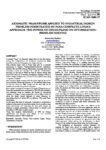
|
Axiomatic Framework applied to Industrial Design Problem formulated by Para-complete logics approach: the power of decoupling on Optimization-Problem solving
Naddeo, Alessandro
4th International Conference on Axiomatic Design, 2006
A primary “must” of axiomatic design theory is the first axiom, stating that independence of functional requirements (FRs) should be maintained throughout the design process. Para-complete logics, such as Fuzzy logic, give us a powerful instrument to express “mathematical/functional” interaction between FRs and DPs (Design Parameters), especially when this interaction cannot be expressed by a precise “mathematical function (i.e. the case in which we want to express several data from VOC (Voice of Customer) investigation, building a FR for a defined design performance), and so can be codified only using “Linguistic variables”. Para-complete logics, among which the Fuzzy logic is, for us, the most powerful, violate the principle of the excluded third party, so that the effects of DPs’ changes on the same FR can be considered partially independent each other. Recent paper investigated changes in Decoupled Design’s concept when para-complete logics are applied in FRs-DPs link definition and evaluated, using an example, the impact of decoupling capability of designer using composition rules on FRs, in order to make the design matrix diagonal or lower triangular by decoupling effects of several DPs on different FRs using Fuzzy formulation. In this paper that kind of approach is extended to optimization method; in this paper we want demonstrate how is possible, using Fuzzy formulation and respecting the first Suh’s Axiom, to elaborate a simple optimization routine based on variation and bounding of DPs values in given ranges. Using that method, Defuzzyfication of DPs for Design optimization will become very simple. A new practical optimization sequence will be explained.
|
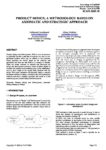
|
Product Design, a Methodology based on Axiomatic and Strategic Approach
Houshmand, Mahmoud, Alieza Mokhtar
4th International Conference on Axiomatic Design, 2006
Product Design and Development, PDD is a set of processes to physically convert a new idea or concept to a new or predeveloped product which can be offered to the customer. These processes are mostly based on the creativity and experience and then are very difficult to manage or transfer. There are several methods to organize and document the design and development processes, many of which neglect to consider the strategies and conflicting goals of the stakeholders such as those stages in the supply chain involved with the design. This paper introduces the axiomatic design, a recently developed method of design, combined with the conventional methods and with a strategic approach that result in a new methodology for product design and development.
|
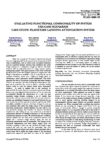
|
Evaluating Functional Commonality of System Use-Case Scenarios – Case study: Planetary landing attenuation system
Bathurst, Stephen, Peter Jeziorek, Taesik Lee, AJ Schrauth, Nam P. Suh
4th International Conference on Axiomatic Design, 2006
While the concept of “functional requirements should drive the design process” is not novel, it is not uncommon to find other considerations, such as system level constraints/objectives and pre-conceived physical solutions that overwhelm the entire design process of a subsystem enough to obscure this basic rationale. That is particularly likely in a large, complex system development project. This paper presents a case study conducted by MIT’s Park Center for Complex Systems in cooperation with Draper Laboratories to establish a way of evaluating the use of common hardware, which was a high-level design driver in developing a space exploration system architecture. This study examines the level of functional commonality that exists between different use cases for a planetary landing attenuation system. The goal was to determine the extent to which a common landing system could be used for various future space exploration missions.
|
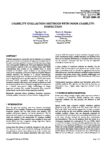
|
Coupled, Profound, and Superficial Guidelines/Heuristics – An Industry Review
Lim, Yee Soon, Martin G. Helander
4th International Conference on Axiomatic Design, 2006
Usability inspection is commonly used in evaluation of computer systems user interfaces. Examples of inspection methods include: heuristic evaluation, guideline review, standards inspection, design rules, and cognitive walkthrough. This paper highlights frequently used inspection methods in the user interface design field. While understanding their context of use, usability issues of these methods are identified – some methods are too profound and some are too superficial, and most of them are coupled. Nielsen’s usability heuristics, for example, is a coupled methodology. Besides being coupled, the heuristics are often too profound and poor in diagnosing context specific problems. On the other hand, functional and/or operational inspection methods, such as standards inspection and design rules, identify problems at a level that is too superficial. Hence, this paper suggests the employment of a formal user-centered design methodology to design inspection methods. The authors demonstrate how axiomatic design theory can be used to design inspection methods.
|
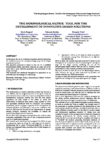
|
The Morphologial Matrix: a Tool to Develop Innovative Solutions
Fargnoli, Mario, Edoardo Rovida, Riccardo Troisi
4th International Conference on Axiomatic Design, 2006
In this paper, the use of a heuristic procedure aimed at improving the performances of the conceptual design stage of the design process is presented. The approach proposed is based on the use of a modified Morphological Matrix, that allows designers an easier and at the same time a more effective generation and assessment of the design concepts. This approach was developed throughout its application to an industrial case: the redesign of a rail boogie.
|
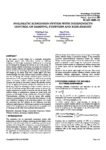
|
Pneumatic suspension system with independent control of damping, stiffness and ride-height
Deo, Hrishikesh, Nam P Suh
4th International Conference on Axiomatic Design, 2006
In this paper, a novel design for a pneumatic automotive suspension system with independent control of stiffness, damping and ride-height is proposed. Stiffness of an air-spring can be changed by changing the volume of air in the spring. In certain existing adaptive suspensions, air springs are employed to achieve variable stiffness and variable ride height by pumping air into or out of the air springs. But this leads to coupling as the DP: Amount of air affects both FR1: Control stiffness and FR2: Control ride-height. Secondly, stiffness change involves pumping air into the air spring and thereby consumes power and is not instantaneous. In the proposed design, we connect the air spring volume to multiple auxiliary volumes through On-Off valves. Opening and closing of the valves, changes the effective volume of the air spring and thereby changes the stiffness of the air spring. By adequately choosing N unequal auxiliary volumes we can get 2N stiffness settings. Ride-height control is achieved by using a compressor to pump in more air into the air-spring. The stiffness change is instantaneous, requires no power input, and involves no ride-height change, making this a decoupled design. Thermodynamic modeling of this air spring with auxiliary volumes is presented and it is shown that flow resistance of the valve introduces damping in the suspension system. As a result the suspension has low stiffness at low frequency and high stiffness at high frequency. Performance analysis on the linearized model of the air spring is used to determine the acceptable level of damping and the valve flow-coefficient that achieves it.
|
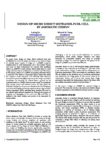
|
Design of Micro Direct Methanol Fuel Cell by Axiomatic Design
Du, Leding, Mitchell M. Tseng
4th International Conference on Axiomatic Design, 2006
In recent years, design of micro direct methanol fuel cells µDMFCs) has attracted notable attentions as new product design of portable power supply. A design of a µDMFC integrates multiple areas of novel technologies into a very limited volume and some of these technologies are coupled with significant effects on µDMFC’s power density, which easily leads to a bad design with low ratio of performance to material cost. Therefore, in this paper, a design of a µDMFC by applying axiomatic design is proposed. The result is a decoupled design matrix that meets the customer needs effectively and efficiently. Two first-level functional requirements (FRs), respectively for energy conversion mechanism and refueling are defined from a general set of customer needs of a Direct-Current power supply. In Constraints Cs), voltage, power and maximal current are taken from the limitation employed in Centaurus Ltd’s Micro Fuel Cell Program; and mechanical rigidity and safety requirements are also included. Design parameters (DPs), satisfying these specified FRs and Cs, are selected with minimal material cost. Through the process of mapping and zigzagging to the next level, FRs and DPs are defined in the same number and proven to be decoupled by design matrix.
|

|
The Importance of Industrial Design in the Consumer Goods Analysis
Tapu, Ermina, Razvan Tapu
4th International Conference on Axiomatic Design, 2006
In the process of a design product, the analyzes and demand identification, the solution that must be found, the analyze and the decision of optimal solutions are very important, especially in the primary phases, when the product needs a demand clarification, the understanding of the concept and the general physical aspect ending. The product mode by a designer reach the end user by the intermediary change, meaning buying and selling, this way the products become merchandise defined by the value of their uses and their utilities.
|
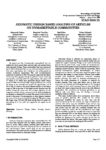
|
Axiomatic design based analysis of articles on unmarketable commodities
Nakao, Masayuki et al.
4th International Conference on Axiomatic Design, 2006
We picked out fifty “unmarketable commodities” that the market put down against their expected sales and analyzed them with Axiomatic Design. These commodities had been introduced by the Nikkei Business Daily as new products that failed to meet their sales expectations. Our analysis set the selling points to primary functional requirement FR1, and countermeasures against the constraints to FR2. The analysis categorized the failure events into three groups. Group (1) gathered events caused by poor product planning within the organizations. The group had 17 events, 9 of which were decoupled designs where design parameter DPi affected other FRj. Group (2) failures were caused by change in the circumstances outside the organization, and 8 out of the 14 events in the group blamed changes in the design range of FRi at the time of the initial product launches into the market. Group (3) events were due to poor alignment of the designer’s concept and the consumer’s needs. Small probabilities for aesthetic or cultural DPi to satisfy FRi caused 13 out of the 19 events in the group. Countermeasures to these failures, whatever the event and cause were, included changing the DP system range, FR design range, DP itself, FR itself, scaling down the project or abandoning it, in the order of magnitudes of impact to the projects.
|
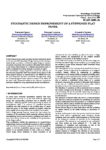
|
Stochastic design improvement of a stiffened flat panel
Caputo, Francesco, Giuseppe Lamanna, Alessandro Soprano
4th International Conference on Axiomatic Design, 2006
In this work an home-made procedure has been developed, based on the so-called SDI (Stochastic Design Improvement) technique, which is able to perform a preliminary robust design of complex structural components; the procedure is illustrated with reference to the design improvement of a stiffened aeronautical panel, in order to maximize its residual strength in presence of cracks. The deterministic analyses required to evaluate the influence of the structural parameters have been carried out by means of the finite element method, as implemented in the WARP 3D code; the crack behaviour has been numerically investigated by using the Gurson-Tvergaard model which is enclosed in the library of the same code. Numerical results on the reference component have been validated by using experimental results from literature.
|
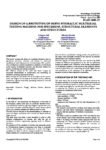
|
Design of a Prototype of Servo Hydraulic Multiaxial Testing Machine for Specimens, Structural Elements and Structures
Calì, Calogero, Michele Perrella
4th International Conference on Axiomatic Design, 2006
This report concerns the design of a machine devoted to test on specimens, structural elements and frames in multi-axial conditions of load, displacement and deformation. The machine was considered as a system constituted in synthesis, of load frame, power supply, oil-hydraulic actuators, and electronic devices for control, monitoring and testing procedures. The different phases of the work start from analysis of functional characteristics to construction and assembling of mechanics, actuating and control groups. More precisely the load frame, that is the subject of the present work, was designed on the basis of functional criteria, stiffness, constructive aspects, modularity, assembling facilities of elements and test specimens.
|
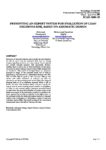
|
Presenting an expert system for evaluation of loan decisions risk, based on axiomatic design
Houshmand, Mahmoud, Mohammad Daneshvar Kakhki
4th International Conference on Axiomatic Design, 2006
Resources of financial institutes such as banks are rare; therefore the risk of return must be minimized while they are making decision regarding acceptance of a loan request. Expert systems can provide financial institutes with appropriate decision, enabling them to reduce risk of their investments. In this paper, we present an expert decision support system which evaluates risk of investment. This model is developed based on Axiomatic approach to design. In the presented model, risk of bank in investment is decomposed in a hierarchical structure into FRs, DPs and PVs. FRs are goals of risk evaluation. DPs are risk criteria with which investment is evaluated and PVs are documents used for quantifying risk criteria (DPs). The designed hierarchy leads us to an evaluation approach which is easy to handle. To make final decisions about each loan request, the request must be scored. Scoring should consider the probability of failure in each evaluated project. Scoring is formulated based on axiom two: the more the probability of project success is the higher score it gets. If the information content of a project is low (more opportunity to finish successfully), it gets higher score. In the presented model, the whole information content of evaluated project is the combination of information content of each risk evaluation criteria (DPs). This model is designed for a specialized development bank in the field of Industry and mine.
|
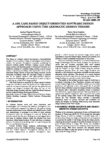
|
A Use Case Based Object-Oriented Software Design Approach using the Axiomatic Design Theory
Pimentel, Andrey Ricardo, Paulo Cézar Stadzisz
4th International Conference on Axiomatic Design, 2006
The design of software systems has become a well-established discipline. Current software design methodologies and techniques enhance the software development processes contributing to improve software quality. However, creating a good software design solution still depends greatly on developers’ expertise. It is difficult to evaluate if a software design solution is good enough without a theoretical foundation. The domain-free nature of the Axiomatic Design Theory, its high-level design concepts, and its theoretical foundation make the Axiomatic Design a powerful tool to be applied together with object-oriented software development methodologies and techniques, in order to help in guarantying the quality of the design solution. This work presents an approach for object-oriented software design that intends to ensure the quality of the design solution along the development process. The goal of this approach is to propose and integrate methods that allow the use of the Axiomatic Design together with the Unified Modeling Language and the Unified Software Development Process.
|
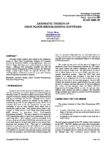
|
Axiomatic Design of Shop Floor Programming Software
Oktay, Türker
4th International Conference on Axiomatic Design, 2006
Axiomatic Design methods were utilized in the architecture design of Shop Floor Programming Software for Computer Numerically Controlled (CNC) turning applications. Two very different design alternatives were evaluated based on Axiomatic Design. Although both alternatives complied well with the Object Oriented Programming (OOP) principles, the Axiomatic Design analysis helped choose the superior alternative. The resulting software architecture turned out to be more modular, easier to implement and easier to maintain.
|
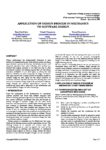
|
Application of design process in mechanics to software design
Fujita, Kazuhiko, Takeshi Yoneyama, Yotaro Hatamura
4th International Conference on Axiomatic Design, 2006
Design methodology has independently developed in each industry for practical production. Each industry carries out design upon common concepts of function, mechanism, structure and constraint separately from other industries. Our studies have revealed that original concepts in one field can map to their counterpart concepts. Our finding suggests that not only design processes established in one field apply to others, but also different industries can share knowledge of design and failure. This paper reports how a design process in mechanics applies to software design by first, laying out the design processes in mechanics and their essential concepts, then showing how each concept in mechanical design maps to its counterpart in software design through the common super-ordinate concept. We conclude the paper with a discussion on the effectiveness and interoperability of design and failure knowledge.
|
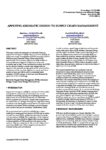
|
Applying Axiomatic Design to supply chain management
Schnetzler, Matthias J., Paul Schönsleben
4th International Conference on Axiomatic Design, 2006
This paper outlines the application of Axiomatic Design to supply chain management (SCM). After an overview of SCM, the supply chain design decomposition SCDD is presented, which is developed using Axiomatic Design. Because the SCDD systematically relates means to objectives of SCM at different levels of abstraction, higher-level objectives can be made actionable step-by-step. Using a structured procedure, the SCDD can be utilized to develop a supply chain strategy that is in alignment with corporate strategic goals and the context and the environment of the enterprise. Moreover, it can be used for an analysis of cause-and-effects and for a sustainable implementation of SCM concepts. A short case study illustrates the application of the methodology.
|
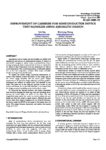
|
Improvement of Carriers for Semiconductor Device Test Handler Using Axiomatic Design
Bae, Ilsin, Woonbong Hwang
4th International Conference on Axiomatic Design, 2006
Apparatuses such as testers and test handlers are widely used together for test process of semiconductor devices. A carrier is a test handler component which carries a semiconductor device during test process. Some semiconductor devices are required to be tested at high temperature and low temperature as well as room temperature. The conventional carrier considerably deflects due to the test temperature variation. This causes unreliable results and frequent test handler jams. To analyze the carrier design, functional requirements of carriers were defined: position the device on the socket, and let the carrier engage smoothly with the socket guide. Design parameters of the previous design adopting a pin-hole guidance mechanism are location of carrier holes, and diameter of the holes. The holes are on the diagonal opposite corners of the carrier, and deviate due to thermal deflection. It is analyzed that the design is coupled according to the independence axiom. To overcome the thermal problem, new design parameters were found by changing the holes into slots and relocating them: location of carrier slots, and width of the slots. The two longitudinal slots restrict the carrier to vertical motion; the one lateral slot does the carrier to lateral motion. Although the slots deviate from their original positions due to thermal deflection, the device under test (DUT) at the center of the carrier does not move. The design becomes decoupled, and enables the concise design of carrier.
|
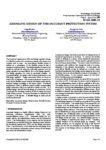
|
Axiomatic Design of the Occupant Protection System
Jeon, Sang-Ki, Gyung-Jin Park
4th International Conference on Axiomatic Design, 2006
The functional requirements (FRs) and design equation change in a flexible system with a continuous manner with respect to a variable such as time. An event-driven flexible system is defined as a subcategory of the flexible system in that it changes in a discrete space. The design equation for each event should be defined by using the axiomatic approach and the design equations are assembled to form a full design equation. The design equations are made by sensitivity analysis. In conceptual design, the design order is determined based on the full design equation. Design parameters (DPs) are found to satisfy FRs in sequence. The occupant protection system is an event-driven flexible system because the design matrix and its elements change according to the impact speed. Functional requirements (FRs) at different impact speeds, corresponding design parameters (DPs) are defined to satisfy the FRs. In a detailed design, the full factorial design of experiments (DOE) is employed for the design variables of DPs to reduce the injury levels of the occupant. Computer simulation is utilized for the evaluation of the injuries. A detailed design is made and the results are discussed.
|
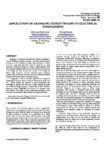
|
Application of Axiomatic Design Theory in Electrical Engineering
Hoshmand, Mahmoud, Hamed Farrahi
4th International Conference on Axiomatic Design, 2006
Designers of electrical and electronic devices, especially in one off jobbing production systems, are facing trial and error process to reach an optimum design. This process is a tedious and time consuming. Therefore most of designers are using advanced computer softwares to reduce design activities time but computer softwares still can not solve trial and error process in the design of these devices. For example in the design of filters, high frequency circuits, switching power supplies, antennas and etc the trial and error process to reach the desired design is still the most time consuming process. In this paper, at first we consider application of Axiomatic Design(AD) theory in simple electrical circuits, such as RC and LC . These circuits are selected to show implication and advantage of applying AD theory in a simple manner. Secondly the traditional design process of Tapped Round Rod Combline Microwave Filter (TRRCMF) is reviewed and compared with AD method. The result of this comparison generated a new corollary and presented a high reduction in design cycle time.
|
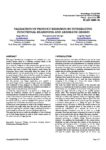
|
Validation Of Product Redesign By Integrating Functional Reasoning And Axiomatic Design
Rizzuti, Sergio, Francescantonio Giampà, Luigi De Napoli
4th International Conference on Axiomatic Design, 2006
This paper describes the development and validation of a new product version made by a Calabrian company, leader in the sector of mechanisms for windows and shutters. Up to now, the designers of this company have operated on the basis of their know-how, employing the trail-and-error method. However, they were conscious that decisions made during the conceptual design phase profoundly affect the quality of the industrial product and the productivity of the company, leading to costly mistakes. Then, they decided to consult the authors to have a “scientific” validation about a new product version, with the aim to limit the investment risks for the firm. For this purpose two design approaches were applied: a functional design and the axiomatic design. Both methodologies were employed to help designers to structure and understand design problems, thereby facilitating the synthesis and analysis of design requirements, solutions, and processes.
|
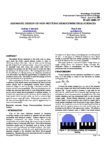
|
Axiomatic Design of Non-Wetting Hemocompatible Surfaces
Schrauth, Anthony J., Nam P. Suh
4th International Conference on Axiomatic Design, 2006
Biomedical devices implanted in the body, such as stents, must avoid the body’s natural defense system in order to effectively perform their task. One of these natural defenses specific to blood is the clotting reaction. Any surface, implanted or externally used, that comes into contact with blood is considered an intruder, and the blood seeks to isolate the object by clotting on the foreign surface. The clotting process involves the identification of a foreign surface, the adsorption of proteins onto that surface, and then the agglomeration of platelets on the proteins to form a clot. The ability to resist the clotting of blood is very beneficial to device performance. Since coagulation is a surface reaction, it is hypothesized that a reduction in the actual contact area between the blood and the surface should lead to dramatically reduced blood clotting. Axiomatic design is used to develop a structured surface to improve surface hemocompatibility. This research shows that the surface area reduction that results in super hydrophobic surfaces can be used to reduce blood coagulation on artificial surfaces. It is shown that appropriate surface structure, slender posts with a larger period relative to their width, can lead to extremely high apparent contact angles. Additionally, it is shown that the same surfaces significantly reduce platelet agglomeration in vitro under static blood.
|
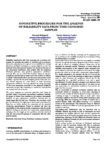
|
Innovative procedure for the analysis of reliability data from time censored samples
Belingardi, Giovanni, Davide Salvatore Paolino
4th International Conference on Axiomatic Design, 2006
Reliability experiments with time censoring are a common test practice for assessing the quality of products and/or processes. Parametric estimation is the target of every reliability data analysis. Maximum likelihood estimators are usually adopted to make the inference from time-censored samples but, except for the case of the exponential distribution, data analysis with the maximum likelihood principle only provides approximate confidence intervals. The use of central limit theorem allows to calculate confidence intervals that are exact only if the number of failures is infinite. Unfortunately, this is not the case of real practice: most reliability experiments test small samples (15-20 units) with very few failures (typically 6-7 units failed). In these situations, approximate confidence intervals, obtained by taking advantage of the good asymptotic properties of the maximum likelihood estimators, can give risky responses, i.e. confidence intervals that are narrower than the real ones. The paper proposes an innovative procedure that allows to calculate always conservative approximate confidence intervals. By means of Monte Carlo simulations, the method, theoretically justified, can give approximate confidence intervals that are always larger than the real ones. Therefore, the procedure could give to technicians and engineers an useful tool to overcome the risks that are hidden behind the application of the standard asymptotic approximations. Finally, an example will show the applicability of the method; besides, comparisons with the results obtained making use of other non conservative approximations will show that the length of the confidence interval calculated with the new proposed approach is comparable with the other interval lengths.
|
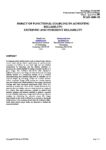
|
Impact of Functional Coupling in Achieving Reliability: Extrinsic and Inherent Reliability
Lee, Taesik, Gyunyoung Heo
4th International Conference on Axiomatic Design, 2006
In designing safety-critical systems such as manned space vehicles, nuclear power plants, military applications, or communication networks, it is difficult to meet their high level of reliability requirements by improving only the extrinsic reliability, i.e. increasing the overall reliability by adding protective barriers to a given design. The traditional Quantitative Risk Assessment (QRA) has focused on the design of safety features by increasing extrinsic barriers in a component domain. It is a common misunderstanding that arbitrarily high level of reliability can be achieved simply by increasing number of extrinsic barriers. Indeed, Axiomatic Design (AD) predicts the extrinsic barriers may even decrease the overall reliability if they create a functional coupling with other functional requirements (FRs). Thus, it is essential to consider the effect of the extrinsic barriers on the system’s inherent reliability whenever those barriers are employed in a system. This paper proposes a method to address both extrinsic reliability and inherent reliability to achieve a required level of reliability. Improving a design itself will increase inherent reliability by eliminating the potential causes. The design improvement in this study is defined as an increase in functional independency. A few examples, drawn from the traditional QRAbased safety system design works, are discussed to validate the proposed method.
|
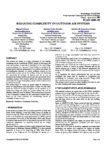
|
Reducing Complexity in Fresh Air Systems
Cavique, Miguel, António Freire Mourão, António M. Gonçalves-Coelho
4th International Conference on Axiomatic Design, 2006
The outdoor air system is a major subsystem of any heating, ventilating and air conditioning (HVAC) system. In this paper, the most used outdoor air systems are described and the usual design recommendations are enounced. Good indoor air quality is the highest-level functional requirement of an outdoor air system. Its accomplishment depends on indoor pollution control, as for example CO2 control, and on the outdoor airflow rate. Reducing the complexity of outdoor air systems may be as easy as increasing the outdoor airflow rate to take into account the worst operating scenario. This solution affects the system dimensions, initial cost and energy consumption, which in some instances may be difficult to handle.
|
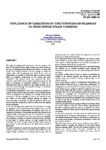
|
Influence of variations in the stiffness of bearings in high power steam turbines
Risitano, Giacomo
4th International Conference on Axiomatic Design, 2006
The logic of programmed maintenance was not always at the base of the design choices made 50 years ago, above all due to the use of technologies quite different from those of today. The result is that today’s technician can be in charge of equipment which, while still functioning, has suffered the wear or deterioration of material to the extent where, at least in certain fields of operation, components of the system have been “modified”. The present study was motivated by direct experience with “dated” steam turbine installations (more than 30 years in operation). In particular, reference is made to an industrial plant where a variation in the critical velocity, due to wear and malfunctioning, has provoked damage to important components of the machine. A preliminary examination of the case in question regarded an analysis of those factors that may impact on the critical velocity, and the development and validation of a suitable model of the machinery. It was then possible to evaluate the variation in first two values of the critical bending velocity in relation to parameters (play in bearings and loss of lubricant) which were found during the maintenance phase to differ from the original design parameters.
|
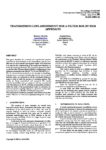
|
Transmission Loss assessment for an air induction system by BEM approachs
Citarella, Roberto, Daniela Siano
4th International Conference on Axiomatic Design, 2006
This paper describes the numerical and experimental activities related to the characterization of the Transmission Loss (TL) of a filter box of a four-cylinder spark ignition engine. The overall aim is to improve the understanding of the component behaviour, in terms of acoustic performance. The numerical approach is based on the Boundary Element Method (BEM) as implemented in two different commercial codes: BEASY ® v.10 and VNOISE® v.2.3. The TL characterization is based on the four-pole methodology. Experiments in an acoustic chamber, based on the use of a sound intensity probe, are performed in all the investigated frequency range in order to verify the accuracy of numerical analyses. The results are finally summarized and compared. The results provided by BEASY code are compared with the experimental ones with reference to the TL, obtaining an acceptable correlation within the limits of the approximations made (no allowance for structural-acoustic coupling). Moreover a qualitative contour plot comparison between BEASY and VNOISE is provided. The employment of different numerical codes informs about their relative efficiency in terms of pre/post-processing time and cpu time.
|
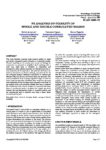
|
FE analysis of stability and collapse of double corrugated boards
Armentani, Enrico, Francesco Caputo, Renato Esposito
4th International Conference on Axiomatic Design, 2006
This work describes nonlinear finite element analysis of single and double corrugated boards subjected to compressive loading. Detailed modelling of the panels, where liners and flutings are represented, is compared to simplified shell modelling with a solid core. Each layer is modelled as orthotropic and homogenous while material properties are estimated from the inplane properties of the paper sheet. The solid core stiffness in the model is determined as effective stiffness, equivalent to that of the corrugated medium. Different combinations of stiffness and thickness ratios for the top and bottom layers are examined. The panel is considered to be as simply supported edges. In order to model particular boundary conditions some constraint equations were established for the boundary edges subjected to the loads. In the analysis, both local and global stability have been considered The results from finite element analyses are compared with those from an experimental study. It is shown that a good agreement between the load-displacement paths of numerical analyses and the experimental tests is achieved even when a linear elastic material model is used.
|

|
A new integrated approach to the design of a race car suspension
Arcidiacono, Gabriele et al.
4th International Conference on Axiomatic Design, 2006
An innovative approach has been used to design the front suspension of the Formula SAE race car of the Università degli Studi di Firenze. The critical review of the 2005 car showed that it’s necessary to improve suspension reliability, reduce Time to Market and costs. DFSS is the only design methodology that allows to resolve these criticities integrating in an organized and structured way several design tools. An Identify – Design – Optimize – Verify (IDOV) approach has been used and through Qualica QFD® has been possible to manage every project phase and the used methodologies like Quality Function Deployment (QFD), Value Analysis and Design Failure Mode Effects Analysis (DFMEA). In the Identify phase, QFD has been used in order to correlate the Voice of Customer (VOC) with the Critical To Quality characteristics (CTQs) and to calculate their importance. In the Design phase the Functional Surfaces methodology has allowed to characterize Functional Requirements (FR) which has been then correlated with CTQs through QFD. Then the Value Analysis has allowed to determine the Design Parameters (DPs) which need to be improved. The suspension Short Long Arm (SLA) is the most important DP, so a new DFSS project has been created to study it. In the new Design phase, Value Analysis has been repeated, Rod Ends and their mounts has proved to be the DP which needed to be improved. These DPs have been redesign, using a Design for Manufacturability (DfM) approach, replacing the spherical Rod End with groved one. DfM has allowed to plan manufacturing processes and to estimate costs with a Bill of Material.
|
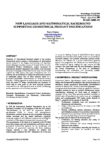
|
New language and mathematical background supporting geometrical product specifications
Chiabert, Paolo
4th International Conference on Axiomatic Design, 2006
Evolution of International Standards related to the product development process requires a harmonisation of technological aspects involved in the design, manufacturing and inspection phases. This paper provides a review of the state of the art in the Geometrical Product Specifications project sponsored by International Standard Organisation and outlines some important fall-outs in technological fields. Based on the most relevant results acquired by GPS project, this paper demonstrates that new solutions can be introduced to manage the technological features in mechanical objects. One of these solutions, based on a generalised probabilistic characterisation of measured surfaces, provides a unifying approach to product geometrical description along the phases of design, manufacturing and inspection. It seems able to solve some of the most annoying problems encountered in the GPS approach such as surface partitioning, surface association and uncertainty expression.
|

|
Optimizing Life Cycle Issues Using Axiomatic Design
Nordlund, Mats
4th International Conference on Axiomatic Design, 2006
The design of a product involves meeting a multitude of requirements from many stakeholders. Typically, in research focus has been on mapping and decomposing requirements starting with Customer Requirements and continuing to Functional Requirements, Design Parameters and so on. In this address, it will be shown how axiomatic design, applied at the level of systems architecture, can accommodate requirements from stakeholders that are concerned with lifecycle cost and life cycle management of the future product. When applied at this level, axiomatic design provides decision makers with the power to make the right decisions and set the right direction in early design phases to meet life cycle goals as well as customer requirements.
|

|
Keys to Success for Six Sigma
Arcidiacono, Gabriele
4th International Conference on Axiomatic Design, 2006
This paper describes how the characteristics of the Six Sigma methodology are able, if properly used, to bring new light to process comprehension and problem solving. Each of the 5 phases in which Six Sigma is structured (DMAIC) sets few milestones that indicate the walk to do. The way these milestones are defined, the ability of the people to understand the contest, the proper effort in order to gain the goal are issues that may influence the final results. Correct use (right one for the right information) of the tools, the rigour of the method, the step-bystep approach and a strict time management on projects are surely the basis for a success. The different examples provided in this pages, show what is the most important aspect of the methodology: its possible application to everything we may define as process. Key issues therefore are: extensive application of the methodology to all the processes, great flexibility and customization, the improvement opportunities identification and selection; results evaluation and validation.
|
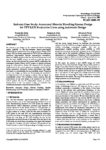
|
Industry Case Study: Automated Material Handling System Design for TFT-LCD Production Lines using Axiomatic Design
Jang, Young Jae, Sangmok Han, Jehanzeb Noor
4th International Conference on Axiomatic Design, 2006
We present a new design of the automated material handling system (AMHS) in thin-film-transistor liquid-crystal-display (TFT-LCD) panel production lines, using Axiomatic Design (AD) Theory. The processing equipment for TFT-LCD has undergone significant improvement through technological innovations. However, AMHS equipment has not had much improvement and uses the same AMHS concept as used ten years ago. For our design, we first decomposed the current AMHS, particularly the Automated Guided Vehicle (AGV) system, to identify problems using the Independence Axiom. We discovered that functional requirements in the current system are strongly coupled by the design parameters. Moreover, system performance was highly dependent on unpredictable and uncontrollable events. Therefore, in our new design, we focus on decomposing the parameterinterdependencies and developing a system that is robust to unpredictable events. The simulation results confirm that the performance of the new design is far superior to that of the current system. We use the Information Axiom to evaluate improvements in the new system. Lastly, we determine the operational parameters using functional periodicity.
|

|
The Role of Axiomatic Design in Business Innovation and Lean Product Development
Dr. Kai Yang
4th International Conference on Axiomatic Design, 2006
DFSS-Innovation and Value Creation
TRIZ, AD and Innovation
Product Development Process and AD
Lean Product Development-Toyota
The Future of Axiomatic Design
|